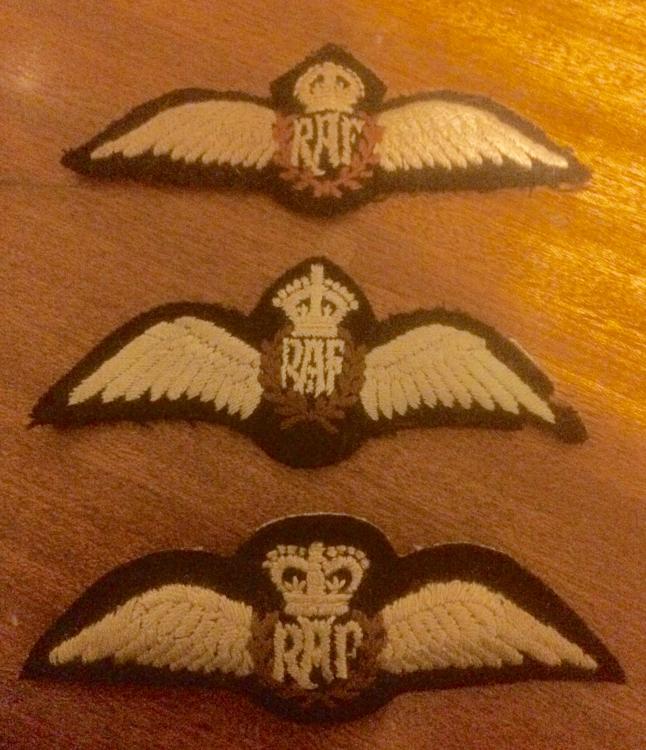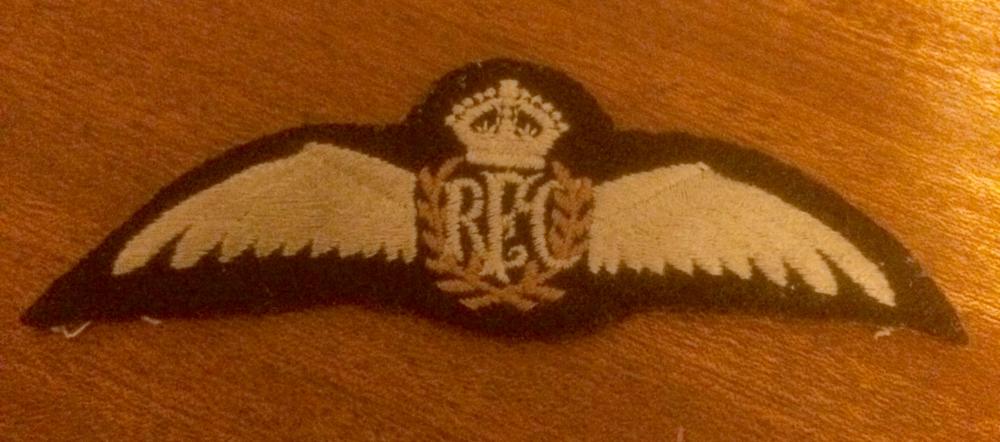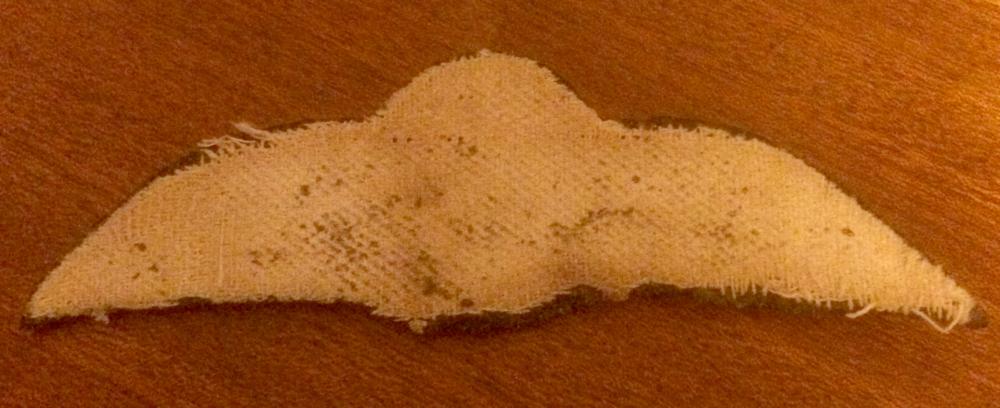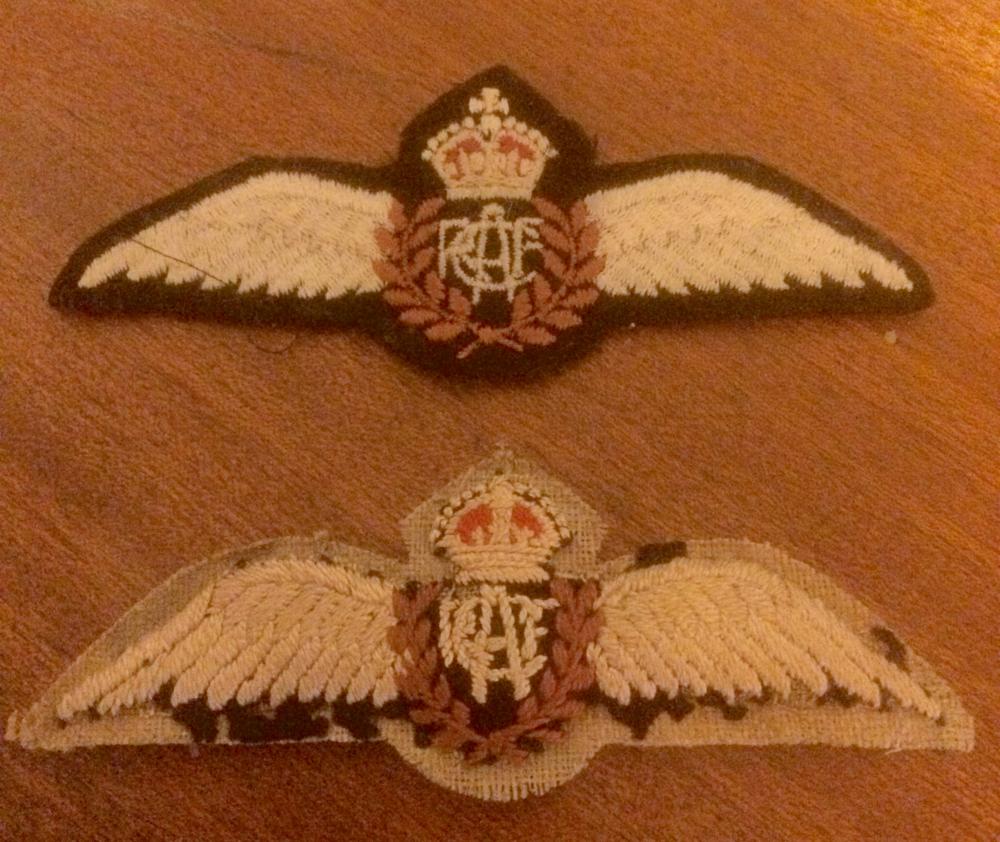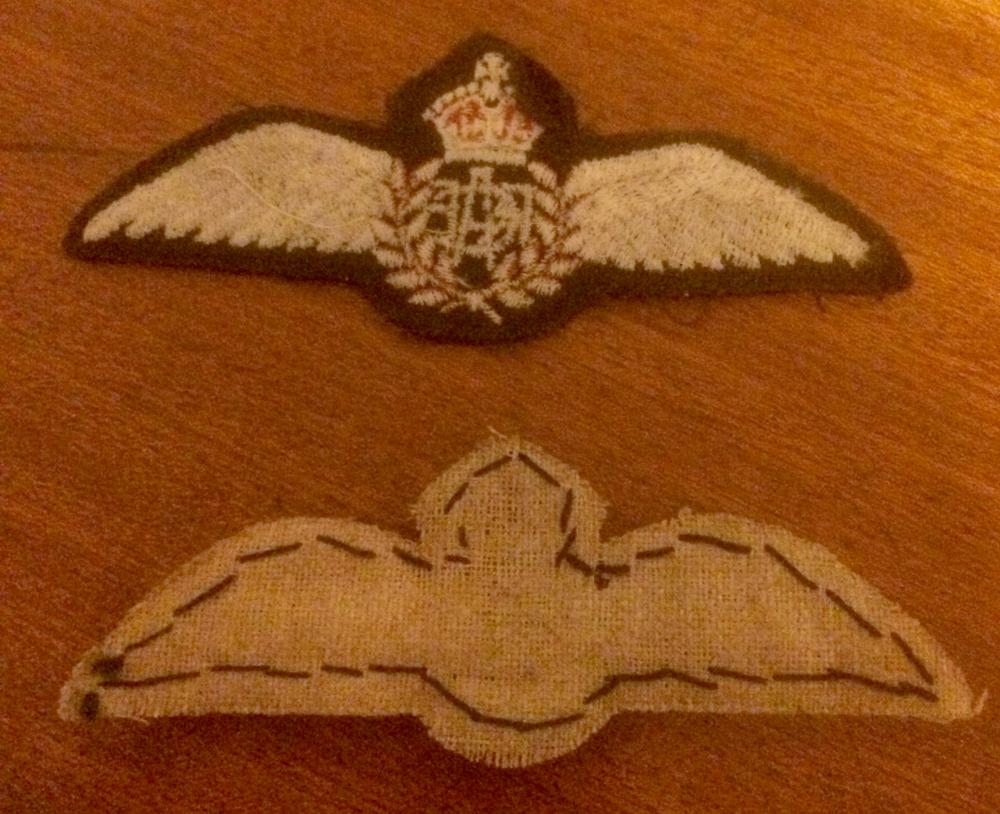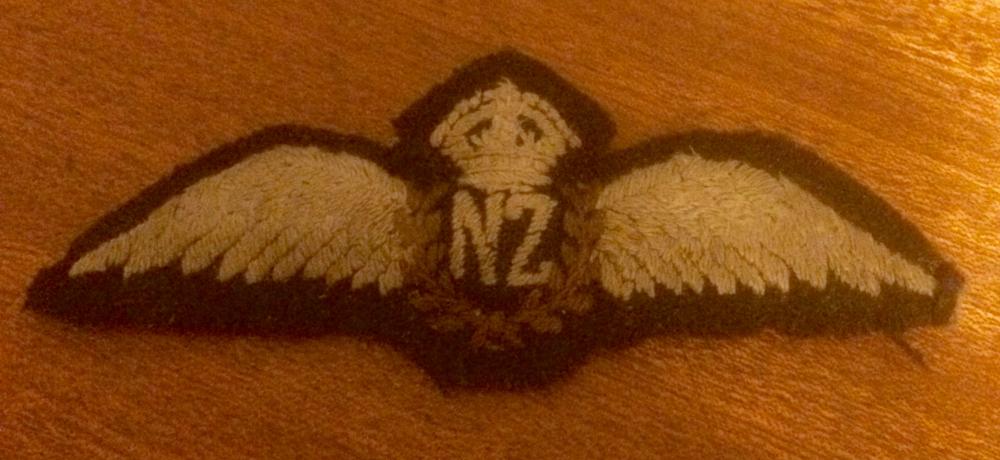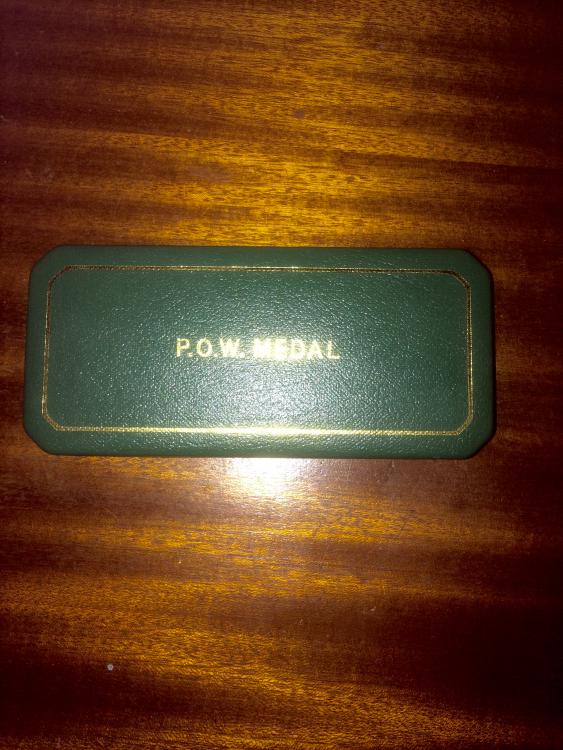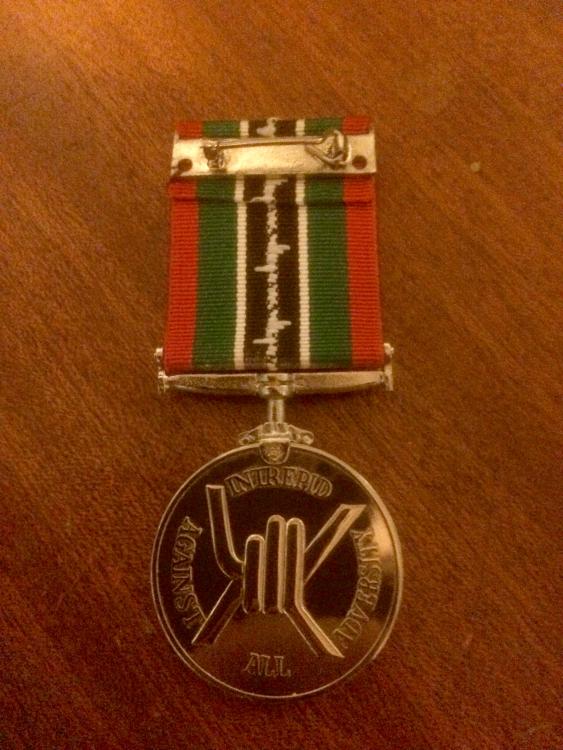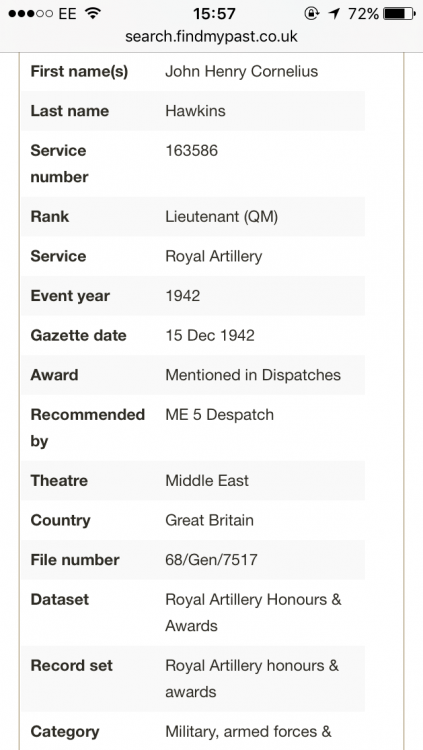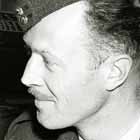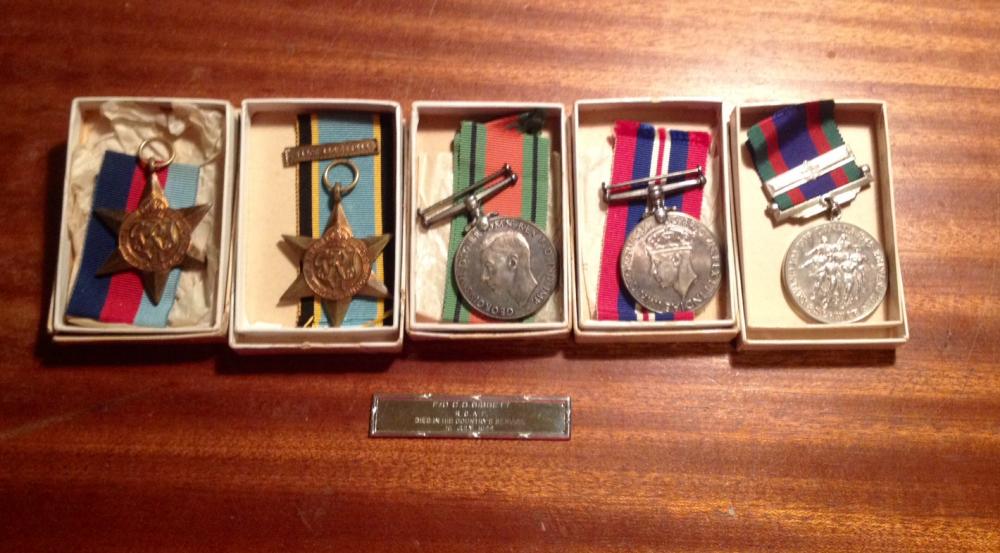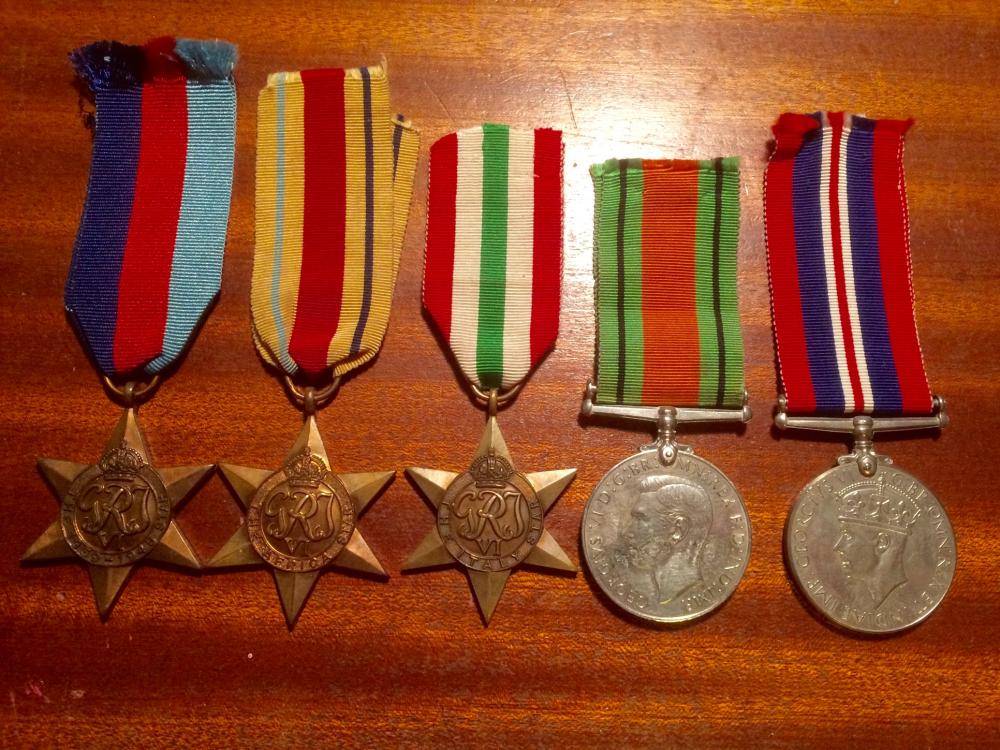-
Posts
220 -
Joined
-
Last visited
-
Days Won
11
Content Type
Profiles
Forums
Blogs
Gallery
Events
Store
Everything posted by POWCollector
-
WW2 RAF and Commonwealth wings and insignia are a great area to collect as there are so many variants, not just in for which country they were awarded to, but also the year of when they were made and also where they were made and the style of manufacture. This is only a very small collection but hopefully others can post their own collections on here? First up are my variants of RAF wings. A padded Pair, a 1943 pattern, a early post war heavily padded pin back pair and an early 1960s mess dress pair. Next up is a Second World War Royal Flying Corps Pilots wings. These were worn by RFC pilots who had served in the First World War who were now serving in uniform in some capacity during the Second. This was usually as part of the home guard. Here are two pairs of RCAF pilots wings. One flat pair and one heavy padded pair. Here is a fairly rare pair of wings. A RNZAF pilots wings in the padded varient, almost certainly a private purchase by an officer
-
Next up is a medal which I just found in my collection and had completely forgotten that I had! The Allied Ex-Prisoner of War medal is a commemorative medal proposed by the Ex-Pow association the UK for all Ex Prisoners whose countries were allies of Britain at the time of their capture irrespective of whether the United Kingdom was involved in the conflict or not. The ribbon has a very specific design. The ribbkn has a symbolised strand of barbed wire bounded on either side by black bands representing the despair of the compound. These in turn are edged by white bands representative of the second and third fences of the compound. The bands of green are reminiscent of the fields of home and finally both edges are symbolic of the burning faith of those who were interned. A very attractive medal, and it is a shame I do not know who this medal was awarded to. There is an issue number on the label on the back of the box so I will contact the company who made them and see if they have a list of who each medal was awarded to.
-
Next up is probably the most visually pleasing POW group in my collection and is a recent acquisition. John Henry Cornelius Hawkins was born on the 8th of September 1901 in Ashton Keyes, Wiltshire On the 23rd of September 1919, John enlisted the Royal Garrison Artillery in Oxford. At the time, he was 5'8, 128 lbs, described as having brown eyes, dark hair and a fresh complexion. After training, he was sent out to Palestine on the 10th of January 1920 and then stopped at Alexandria and Malta. After arriving back and serving at home in early 1922, he was sent out to Constantinople (Modern day Istanbul) arriving on the 29th of September 1922 serving here until the 6th of September 1923. This coincided with the end of the Greco-Turkish war of 1919-1922 and the collapse of the Ottoman Empire. After this, John served at home from 7/9/23 to 27/4/34. Next was Gibraltar from 28/4/34 to 20/9/35, Egypt 21/9/35 to 1/9/36 and back to Gibraltar until the 28th of January 1937 before being sent back home for service there.By this time, he had worked his way from Gunner to a Sergeant. During his time in the ranks, he passed qualifications in 3rd, 2nd and 1st class education, Class A swimming and qualified as a signaller. He was awarded his Long Service and Good Conduct medal (Sadly missing from the group) with Gratuity in 1938. He was posted to the 68th HAA Regiment as a Sergeant on the 9th of April and on the 1st of May 1938, he was promoted to Warrant Officer 2nd class being promoted to Warrant Officer 1st class and Acting Regimental Sergeant Major on the 1st of May 1939. Around this time he was awarded the Meritorious Service Medal and on with the second world war breaking out, he was promoted to War Substantive Regimental Sergeant Major on the 2nd of December 1939. In 1940 he was recommended for officer training. His conduct was described as Exemplary and the testimonial is as follows: "A Warrant Officer (class 1) of the best type - well educated, efficient, reliable and a good disciplinarian. RSM Hawkins has a record of good service of which he can be justly proud. His work and conduct have been beyond reproach at all times and his energy, ability and trustworthiness have now been rewarded by his promotion to commissioned rank. His fine example merits the highest praise". Once his officer training was complete, John left Liverpool as a Lieutenant on the 6th of Febuary 1941 and arrived at Durban on the 22nd of April 1941.From here, he travelled up to North Africa being seeing action in the Middle Eastern theatre. John was Captured on the 17th of July 1942 at El-Alamein and was confirmed as a prisoner on the 22nd of July. On the 15th of December 1942, John was Mentioned in Despatches presumably for his actions at El-Alamein. From here, John was moved to Campo 21 at Chieti, an old monastery which had a particularly evil Fascist commandant who public beat to death a recaptured officer who had escaped the camp. At the time of the Capitulation, the senior officer followed his orders and did not allow any prisoners to leave the camp, even posting his own officers as guards. The Germans unfortunately took over the camp. There were quite a few tunnels being dug from March 1943 and about 40/50 officers hid in these tunnels (for example, John Jenkins whose medals i own and are written about previously in this thread). Since John's service record confirms that he was entitled to the Italy star, he must have escaped the camp by hiding in the tunnel and emerging after the rest of the prisoners had been taken away on the trains. He might have been in the one of the parties who met the A Force agents and SAS/Para's who were sent to round up Ex-POW's or he might have joined Partisans and fought briefly with them. Either way, he found himself being recaptured and sent to Oflag 8F in Czechoslovakia. This camp was moved to Oflag 79 in Braunschwig in April 1944 and John went with them. He was Liberated by the Allied forces on the 12th of April 1945 and jumped straight back into action serving for a month in North West Europe. From here he was sent back to the UK. In 1953, now a Major, John was recommended for the Military Division M.B.E which was approved and awarded for the Coronation Honours on the 1st of June. The recommendation for the award is as follows; "Major (Q.M) J.H.C Hawkins R.A, has been Quartermaster of 262 (M) H.A.A Regiment R.A (Territorial Army) since the reconstitution of the Territorial Army in 1947. Throughout this period, he has shown a devotion to duty which far surpasses the requirements of his appointment. He has worked tirelessly and devoted by far the greater part of his leisure time to the affairs of his Regiment, particularly in regard to the social and welfare side. He has made it his business to extend his military knowledge to an astonishing extent and, not only is he a tower of strength to his own regiment, but in addition on many matters his counsel is sought by higher formations. His ceaseless vigilance both on and off duty, the breadth of his knowledge, and the wisdom of his counsel have contributed more than any other single factor to the growing success of the Regiment throughout the period since it was reformed. After thirty three years of service in the Regular Army, of which the last thirteen have been commissioned, Major Hawkins is shortly to retire. He has set for himself the highest possible standard of service, and i cannot praise too highly his achievements over the past years. I strongly recommend the award of the M.B.E in recognition." John Hawkins was clearly a very professional career soldier who must have had a lot of respect from his seniors and subordinates alike. He saw lots of the world as a soldier and must have endured many hardships during the war and his time as a prisoner. I was very pleased to find his POW Mugshot picture and to notice he sported a very impressive moustache!
-
Hi Guys, I have the Khedive's star 1882 and an interesting Royal Humane Society Medal which is named to a distant relative of mine, Petty Officer J Daltry, HMS Audacious for saving the life of Ada Rawson from the River Humber in Hull on the 8th of July 1892. To earn the khedives star you had to have the Egypt Medal which is sadly missing. I wonder if anybody has access to the medal roll so i can find out which clasps he would have been entitled to? i would like to get a replacement until the original turns up (if it ever does!) Many thanks, Rob
-
John, Id love to reunite a group soon! Must feel so rewarding to bring the medals back to one collection. I have a Royal Navy Petty Officers medals to a relative, i have his Khedives star and Royal Humane Society life saving medal but his Egypt medal is sadly missing! Hopefully it will be somewhere at my grandmothers house where the others came from. I also had the pleasure of buying a Victory medal and Plaque to a 19 year old who was from my village. I used to sit next to his name on our war memorial in church back when I was a chorister! He died in April 1918 and had already been serving for over a year so he may have enlisted at 17! Sadly the BWM isn't there so i have a bad feeling that it was scrapped in the 1970s when the silver prices rose. My next post will be a long one to the MBE officer i mentioned to you, i'm sure you're going to enjoy it! Got my hands on his mugshot photo too which is brilliant, i love putting a face to a name! Rob
-
Next up is a fairly recent first world war purchase that i forgot to post about a while ago. Harry French was born on the 15th of Novemeber 1892 in Worksop, a town on the Northern Edge of Sherwood Forest in Nottinghamshire. He lived at 35 Belmont House, Doncaster. Harry enlisted as 20591 Pte French of the 1st Battalion Kings Own Yorkshire Light Infantry and entered France on the 21st of April 1915. Harry was captured during the Second Battle of Ypres on the 8th of May 1915, only 16 days after he landed in France. His first camp was Giessen, then he was moved to Lichtenhorst from the 23rd of August 1916 til the 2nd of December 1916 when he moved to Langensalza from which he was repatriated at the end of the war. One of Harrys comrades from the 1st KOYLI's was wounded and sent back to England to recover. On the 5th of June 1915, the Sheffield Daily Independant published his account of the Battle which led up to his wounding and Harry French's capture. "My share in the battle was 21 days and nights of fighting before being wounded. On 8 May the Germans bombarded our trenches in a terrific manner for about eight hours, and then made a charge. They came in thousands, in the struggle about 34 of us found ourselves alone in the trench we were holding. Whether our comrades were taken prisoners or not we do not know. The Germans set fire to a building on our left flank, and we could not see what was happening owing to the thick smoke and being engaged in checking the advancing enemy. With our two machine guns and rapid rifle fire we mowed them down as they came along. Unfortunately our numbers were reduced to 18. The German artillery was constantly shelling the wood behind in order to prevent reinforcements reaching us, but at the same time they were keeping their own men from surrounding us. The few of us were expecting at any moment to fall into the hands of the Bavarians we were opposed to, but when the smoke had cleared away all we could see were the bodies of the dead Germans." He went on to relate that he and his comrades had made their way to a position occupied by another regiment. The Germans then made another assault: "I had a narrow escape. My hat was blown off by a bullet, which did not even touch my hair. About half an hour afterwards I felt a sting at the top of my right arm, and found that I had been shot. The pain gradually got worse. I could not use my rifle, but I managed to give ammunition to the others. Those who were wounded had to proceed to the dressing station about a mile away. We crawled for some distance on our hands and knees till we came to a road that leads to a wood where the Germans were. We stood up and made a dash, but the enemy had someone waiting for those who might try to cross. We had reached the centre of the road, when my comrade was killed on the spot. I received a nasty wound in the body from an explosive bullet. I managed to scramble into some ruined buildings, though I was losing a great amount of blood. No one heard my calls for help, but I managed to bite open my field dressing and place it on my wound. I became very weak, and had given up all hope of being saved when an officer came dashing past and helped me." A rather interesting medal, sadly i only have his 1914-15 star and his BWM and Victory medal are still out there. Maybe one day they will be reunited!
-
Hi Guys, I have an officers Pow group to a man who was taken prisoner at El-Alamein in 1942, he was mentioned in despatches on the 15th of December 1942 and I would massively appreciate help finding the recommendation. His service record showed entitlement to the Italy star even though he was held at PG 21 chieti so I wonder if he escaped from North Africa and was captured in Italy in 1943? His name was Lieut John Henry Cornelius Hawkins Royal Artillery. Find my Past has a file index for the MiD which I will add later when I am at my computer. if any costs are incurred I will happily reimburse and give a little profit for kindly helping me out! If he escaped in North Africa then that would explain the Italy star but if not, he must of escaped for a while whilst at chieti to be entitled to it. A very interesting story could come from this! Many thanks, Rob
-
Next up took some detective work but luckily enough, the name is unique enough so that I was successful in identifying this chap. I saw this group on a dealer website for £100 including next day delivery and the combination was enough to spark my interest. The group is: The 1939-45 star, Africa star, France and Germany star, War medal and QE2 Territorial Medal - the last named to 21002238 Sgt P.A.D Cartwright. I knew that this combination would indicate a birth after 1921 since he wasn't in the Territorials during the war since he got awarded the T.M post 1953. The group indicated to me that it was an Arnhem POW. Peter A.D Cartwright was born in the second quarter of 1923 in Edmonton, Middlesex. Peter joined the General Service Corps and was probably sent to the Royal Artillery with service number 14242349 probably in mid 1942 and was sent out to North Africa. After his time in North Africa, he transferred to the Army Air Corps (still trying to find out if he was a Para or Glider Pilot regiment) but he was taken prisoner at Arnhem and held at Stalag XI-B at Fallingbostel as PoW 117911. After he was repatriated, he returned to civilian life but his QE2 territorial medal service number would indicate a pre 1950 enlistment. Probably around 1948-49. Coincidentaly, Peter and his wife (Married in '41 probably just before leaving for Africa), had a son who was also P.A.D Cartwright who was born in 1949. Peter most likely joined the Territorials to earn a bit more money due to starting a family. I am trying to get hold of his POW debrief if it exists and I'm hoping above hope that it does as most Fallingbostel POW's that I've researched did fill out debriefs! It is very nice to see a QE2 territorial medal to an Arnhem AAC pow and can't believe my luck to have found it! (For such a bargain!) Sorry about the poor quality photo!
-
Hi Brian, I look forward to your upcoming write ups! I saw that on John's collection post, you mentioned that you had an SAAF pilots group which i look forward to! My favourite of you collection is your group to Sgt Wilkinson who was M.I.D for his escapes! Such a cool story, on my list of things to tick off is the medals of somebody who escaped wearing a pow made or stolen axis uniform! Ive got a couple of interesting groups which is need to write up, but im about to start my uni exams so time is the issue! Take care, Rob
-
Hi Chaps, Thanks very much for your input, i've read the article which mickey sent (very interesting to read to many thanks!) and i agree that there is a decent chance that it was a Blue on Blue incident. If you guys are interested, I posted some info along with the pictures of the medals to one of the 12 men who died on that march on the 27th of Feb 1945 on my post called 'My Prisoner of War Collection' which is on the Great Britain section of the forum along with the rest of my pow stuff! (Brian, i really enjoyed seeing your collection on the forum too!) Rob
-
Hi, A very plausible explanation, I agree. There were a lot of reports of men being shot for collapsing or falling behind, even stories of the guards themselves being so exhausted that they asked the prisoners to carry their weapons which were promptly thrown off the sledges when the guards weren't looking!! However, I have 3 groups to POW's who escaped from the forced marches despite being marched to the west who met the Russian and British lines a couple of weeks before the collumns were liberated. I feel both the summary executions and the escape are plausible so I might try to find some of the 'Form Q's' to prisoners from this camp to see if any war crimes regarding the march occurred. Thanks for your speculations, would be very keen to hear some other people's opinions on the subject too!
-
Hi All, For a couple of years now i have had this group in my possession but I have never really researched it. I recently decided that it would be good to have a try to find out anything new and to my surprise I have uncovered a fascinating story! Firstly, the medals are the 1939-45 Star, the Air Crew Europe Star with France and Germany Clasp, Defence Medal, War Medal and the Canadian war service medal with the Overseas Clasp. Lastly, there is the Silver Birks Casualty bar named to him. These awards are all confirmed on his Service record which I have. J/15762 Flying Officer Clarence Deane Sibbett was born in 1910 and went by his middle name of Deane. He was the Son of Henry Thomas Sibbett and Annie M Sibbett. He was a native of Vancouver, British Columbia in Canada. He was a graduate of the University of British Columbia and was married to a Mrs Sylvia M Sibbett. He served as a Navigator in De Havilland Mosquito's with 410 Squadron and later in 409 Squadron. Both of these were Tactical Fighter Squadrons. After a bit of internet research, I have uncovered the fact that he served as a Navigator/Observer to a number of Pilots. The First of these was Flying Officer E.S.P Fox with whom Sibbett joined 410 Squadron in late August 1943. The following excerpt is taken from the history of 410 (Cougar) Squadron; 'The first 3 weeks of September were somewhat quieter than August had been. Ranger sorties were cancelled, but flower operations continued in support of Bomber Command with 15 sorties between the 3rd and 16th. These resulted in six bombing attacks on St. Michel airfield, Laon airfield (twice), one railway bridge near Avranches, another south of Rennes and a marshalling yard near Fourgeres. In addition Flying Officers E.S.P Fox and C.D Sibbett, who had joined the squadron in August, blew up a locomotive in the last attack of this type carried out by the Cougars.' 'On the night of the 3rd/4th of January 1944, Flying Officers E.S.P Fox and C.D Sibbett stalked a violently jinking Dornier 217 that was scattering 'window'. The first burst missed, but Fox clung to his quarry for tine (sic) minutes despite its frantic manoeuvres until he could get in another long squirt. A large piece flew off the starboard side of the Dornier; then it exploded and went straight down in flames, striking the sea with a flash that lit up the clouds over a wide area.' This was the second confirmed 'Kill' credited to Flying Officers Fox and Sibbett. In March 1944, when Sibbett had transferred to 409 squadron (The Nighthawks), He was partnered with Squadron Leader Richard Jephson. Midnight is Noon for Nighthawks (the history of 409 squadron) takes up the story: '409 Squadron flew its first sorties over the beachhead. Patrols on the 6th, 7th and 8th were uneventful, largely because of the Luftwaffe, apart from a few scattered raids, were late getting into the fray. On the 9th, Squadron Leader R.S Jephson, "B" Flight Commander, got the first kill over France. Jephson and his navigator, Flying Officer C.D Sibbett, were flying a beachhead patrol when the controller vectored them after a bandit. Sibbett's AI soon registered a "Blip" and the navigator brought his pilot onto the tail of a JU.88. Following standard night fighting procedure, Jephson closed in, identified his target, and opened fire. His first burst set the enemy's starboard engine on fire, a second started a blaze on the port engine, and as the Nighthawk pilot pressed the firing button once more the fuselage disintergrated and the plane fell from the sky exploding as it hit the ground about 30 or 40 miles South-East of Le Havre.' The university of British Columbia had a regular news section about past alumni throughout the war and i have found this extract: Flying Officer Clarence D Sibbett, RCAF - Shot down a German aircraft near Le Havre while on patrol over France - Also shot down a Dornier 217 in a raid over London during March. These are Sibbett's 3rd and 4th confirmed 'Kills' as a Navigator! Finally, Sibbett was partnered with Flying Officer Murray Taylor whilst still serving with 409 Squadron. Aircrew Remembered - 409 Squadron the Nighthawks gives the following details: 'The hectic nights between D-Day and the allied break through at Caen when combats were almost a nightly affair. And some of the crews who scored: - Murray Taylor and Deane Sibbett; Ken Livingstone and Jack Boomer; Mac MacDonald and Curly Colborne' and the list goes on.. I have not researched this any further but it would appear that Sibbett was actually a Navigator/Observer ACE!! Clearly, more research is needed to find out about the Kill(s) that Taylor and Sibbett were credited with! Sadly, on the 15th of July 1944, whilst on Evasive Action training, Flying Officer Murray Taylor and Deane Sibbett's aircraft lost control and crashed. Both officers were killed outright. It is amazing to me that Flying Officer Sibbett was not awarded the Distinguished Flying Cross as I have seen awards for far lesser achievement to be completely honest! Sadly, as fascinating as this is, I bought this group when I was really big on Fighter Command groups but now I have moved onto POW's so it doesn't fit my collection anymore! I'm not sure if this is really bad form but i am getting rid of this group and it can be found in the Sale Room section of GMIC. I hope you have found this post as interesting as I did when I was researching it! As you are probably aware, it is rare to find such detailed stories of the 'Kills' so it was such a brilliant purchase and a shame that my collecting field has changed!
-
Hi Paul, I am glad you have enjoyed these posts, I am rather fond of the Korean set too! Could not believe my eyes when I saw it on eBay at a lower price then what id already bid at auction! Ive missed out on some other amazing lots in the past, so fingers crossed I'll get another chance at some of them too! Rob
-
Next up is my first POW Casualty group. This group of medals are the 1939-45 star, Africa Star and 1939-45 War Medal but sadly the Africa War Service Medal is missing. They are named to 214378 Trooper F Horrocks of the 7th Reconnaissance Battalion of the South African Tank Corps who was captured at Tobruk on the 21st of June 1942. At the time, the battalion was equipped with Marmon-Herrington II armoured cars. On the 13th of July 1942, the battalion was disbanded as the casualties were so numerous as either killed or taken prisoner. Horrocks was initially held at PG 85 but after the Italian Capitulation, he was transferred to Stalag 8c at Sagan which was alongside the infamous Stalag Luft 3. He was given the POW number 76111. This is where the story gets more interesting.. On the 8th of February the camp was evacuated and marched away from the advancing Russians and they were marched just over 500km to Stalag 9b at Bad Orb which is notorious for being the POW camp with the worst conditions. Sadly, Trooper Horrocks never made it. Along with 11 other South Africans including a couple of his fellow 7th Recce Battalion, S.A.T.C comrades, Trooper F Horrocks died on the 27th of February 1945 and was buried in a mass grave with them at Obergrunstedt which was 325km from Stalag 8C at Sagan. I am of the belief that these men all attempted to escape and were killed in the process. My reason for this is that only 22 South African Servicemen died between 01/01/1945 and 28/02/1945 and were buried in Germany or Poland. All of the other ten casualties had died on different days and were interred in a range of cemetery's where as the 12 including Horrocks were all found in a mass grave at Obergrunstedt and all died on the same day. I think that is especially more likely that they had tried to escape as there were 3 men of the same battalion who were captured together and would have been friends. At first i thought it unlikely that a group this size would try to escape so i dismissed the theory, but then i read an MI9 report of a man who escaped the march at night in a group of roughly 50 men and made it to the allied lines! The only other reason that i could think of 12 prisoners dying on the same day would be if they were accidentally strafed by allied planes, however, i cannot find any reference to the allied forces accidentally strafing this group of prisoners. Only the more famous cases like the Stalag 357 Fallingbostel forced march. If anybody has any thoughts/theories i would love to hear them, and also if anybody has access to the Reports regarding war crimes from Stalag 8c i would be very interested to see what they say! Trooper Horrocks was the son of James and Alice Horrocks of Port Elizabeth, Cape Province, South Africa and in 1951, his remains were removed from the original mass grave at Obergrunstedt and reinterred in at Berlin War Cemetery for 1939-1945. He was 32 years old when he died. Sorry again for the pictures being the wrong way around!!!! If anybody knows why this keeps happening when i go to upload them/how to rotate them, please let me know!
-
Another recent acquisition; 2581920 Signalman Gerald Hedley Rouse of the Middlesex Yeomanry, 2nd armoured signals division was born on the 31st of January, 1921. He enlisted in the Territorial Army on the 26th of April 1939 and at the time of enlistment was a Bank Clerk living at Lamarrack, South Park Road, Par, Cornwall, England. Gerald was sent out to North Africa with the 2nd Armoured Division but was Captured at El Mechili, Libya on the 8th of April 1941. From here, he was taken to Prato All Isarco near Bolzano in Italy, probably via Benghazi and or Derna, arriving here on the 12th of August 1941 and leaving for a permanent camp on the 23rd of October 1941. On the 24th of October 1941 he arrived at his new home for the next 2 years at PG 78 at Sulmona. On the 8th of September, the Italians capitulated and fled from the camp and thankfully the commanding officer decided to ignore the 'Stay Put' order and let the men try to escape. On the 12th of September, along with Signalman M.E Clarke or the Royal Signals and W.F Gell of the Australian Imperial Force, Gerald left the camp and made his way south towards the advancing allies. On the escape section of his MI9 debrief, he wrote that unfortunately he was 'Recaptured by a German Foraging Force while attempting to reach our front line. All three were taken to Germany.' Unfortunately he doesnt give the length of time that he was out, but he arrived at Stalag 7a at Moosburg on the 12th of November 1943. This would imply that he was out for pretty much two whole months so he must of damn nearly made it. On the 29th of April 1945, the 14th Armoured Division of the United States Army liberated the camp after a short and uneven battle with the retreating Germans of the 17th SS Panzer Grenadiers and the 719th infantry divisions although they only possessed small arms and most of them surrendered along with the 240 camp guards. Gerald filled out his MI9 Debrief on the 12th of May 1945 and then returned to civilian life. unfortunately I only have his Territorial medal and as his other entitlement (39-45 star, Africa star and War medal) are missing and as they were issued unnamed, they will probably never be reunited which is a shame but its nice to have his territorial medal in the original box although its sad that he probably never wore his hard earned medals. PS sorry about the images being sideways! They were not taken sideways but for some reason when i uploaded them, they turned at 90 degrees and i cant figure out how to rotate them!
-
Next up is a very ordinary combination of medals to an extraordinary man. Arthur Thomson was on the 8th of September 1922 in Newcastle-on-Tyne in England. He enlisted into the 9th Battalion Durham Light Infantry on the 14th of May 1942 and at the time of enlistment worked for the Cooperative. 3608465 Pte Arthur Thomson was sent out with the 50th Northumbrian Infantry Division to North Africa in the late 1942 to reinforce the 9th Battalion Durham Light Infantry to replace the troops lost as killed or prisoner during the Mersa Matruh Battle on the 27th of June 1942 in which Private Adam Wakenshaw was posthumously awarded the Victoria Cross. On this day, the 9th Durham Light Infantry lost 20 men killed and 300 taken prisoner. On the 3rd of December 1942, the 9th Durham Light Infantry moved to Galal. During the capture of the 300 prisoners at Mersa Matruh, the battalions payroll of £600 was buried by Lt Pickering. Some more enterprising members of the battalion decided that, although it would be like trying to find a needle in a haystack, to return to the scene to try and find the payroll. Sgt George Lambert, Pte Arthur Thomson, Pte Len Green and Pte Dai Jones returned to the scene of the battle but did not find the payroll. However, what they did find were the bodies of Pte Wakenshaw VC and two other comrades, unburied lying exposed in the Desert. The men reburied their comrades and Sgt Lambert arranged for a Cross for each of the Graves. Arthur later served with the Battalion during Operation Pugilist at the Mareth Line in March 1943. Next up for Arthur Thomson was Operation Husky, the invasion of Siciily and it was here that Arthur was captured on the 19th of July 1943. He was sent to PG 66 where he arrived on the 20th of July. PG 66 which was at Capua, was a transit camp and conditions were pretty rough. During his time here, he suffered from Malaria but he stated that he was given adequate medical treatment. On the 25th of September 1943, Arthur Left the camp and he was taken to Stalag 18a at Wolfsburg in Austria as Prisoner number 7281. From the 14th of October 1943, Arthur was employed on the Arbeitskommando 107/GW at Graz which was a work detail for building air raid shelters. Here he met a fellow Geordie lad named Leonard Slater. In Febuary 1945, Pte Thomson and Dvr Slater decided to escape. In his MI9 report he gave the following account of their escape. 'When we were out working, we decided that we would have a try and when the air raid siren started and the guards werent looking, we were lucky and got away.' He goes on to elaborate on this; 'Walked off job avoiding guards, wearing Battle Dress. No food. Fit with Dvr Slater, L Royal Artillery. Sheltered by a family in Graz for 14 days. Recaptured and returned to the camp. 3 Days later we were taken to Graz station to be sent back to Wolfsberg for punishment under German guard. At dusk, escaped as guards attention was elsewhere (Air Raid Siren). Picked up at Voitsberg at the end of March 1945. Recaptured wearing civilian clothes and placed in Gaol and the Germans didn't realise that we were prisoners of war. We said that we had to report to the police and German officer allowed us to go unquestioned so we made our way back to Graz and stayed with civilians until liberated by advancing troops.' Arthur Thomson and Leonard Slater were liberated on the 11th of May 1945. Arthur Thomson stated on his MI9 debrief that Anna Heissler who lived at 13 Bahnhof Girdal Strasse, Graz, Austria 'Sheltered and gave me food and clothing and kept me hidden from Gestapo, SS and all who were after me. I have her address as she was very good to me and had to be very careful. She has not got my address. I was with her for 4 months.' I am very surprised that Arthur wasn't at the very least Mentioned in Despatches for his Escape as he technically escaped 3 times using much initiative and subterfuge. Him and Slater must have been good Linguists to manage to fool the Germans into letting them leave the Gaol. Accompanying the medals are a few documents, which include the notification that he was a prisoner of war at Capua, funnily enough the date is the day he left Capua. Also included were his rejoining order after he was liberated and a document which is sadly only a half document related to his escape along with a pay slip and a national insurance document. Arthur had a very interesting war and it is nice to have the medals of a man captured in an operation which is new for my collection let alone a man who had a magnificent escape!
-
Hi all, Wondering if anybody has access to the war crimes reports filed by prisoners from stalag 8c? On the 27th of February 1945, 12 South African prisoners who were on the March from stalag 8c at Sagan, died. I have only found 17 South Africans total who are buried in Germany and Poland who died in Feb 1945 and 12 of these were on the same day and are buried in a mass grave together all having been recovered from the same site in the early 1950s. 3 of these 12 were of the same battalion and were captured together at Tobruk. Is it likely that these men were shot attempting escape or as reprisal for escape? I find it unlikely that they all happened to die of starvation or the cold on the same day in the same location? Any help or speculations would be appreciated! Rob



